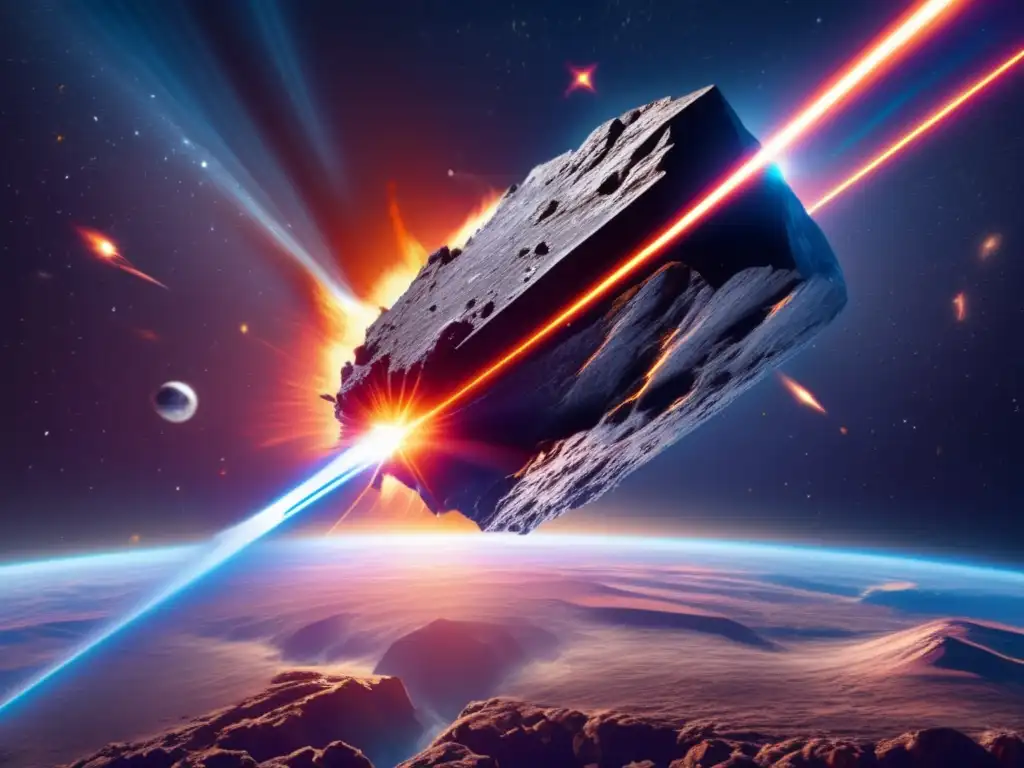Fighting Fire With Fire: Technologies Against Asteroid Threats

Introduction
Asteroids are some of the most fascinating celestial bodies in our solar system. They provide insight into the history and formation of our universe, and they also pose potential threats to life on Earth. The possibility of an asteroid impact has long been a topic of concern among scientists and space enthusiasts alike. However, there are several technologies available that can help us defend against asteroid threats. In this article, we'll explore some of these cutting-edge technologies and how they can be used to protect our planet.
Laser Beams: A Powerful Weapon Against Asteroids

How Do Laser Beams Work?
Laser beams are powerful beams of concentrated light energy. They can be used to heat up and vaporize small portions of an asteroid's surface. This can create a small thrust force that can be used to alter the trajectory of the asteroid. By firing laser beams at an asteroid over a long period of time, we could potentially deflect it away from a collision course with Earth.
Potential Challenges
The main challenge with using laser beams is that they require a lot of energy. We would need an incredibly powerful, high-energy laser to be able to effectively deflect an asteroid. Additionally, the accuracy of the laser would need to be incredibly precise to avoid causing damage to the asteroid or creating debris that could pose a separate threat.
Current Research and Development
Several organizations, including NASA and the European Space Agency, are currently researching and developing laser-beam technology for asteroid defense. One proposed project called the Hypervelocity Asteroid Mitigation Mission for Emergency Response (HAMMER) would use a spacecraft equipped with a nuclear weapon to deflect an asteroid. The spacecraft would also be equipped with a laser system to help fine-tune the asteroid's trajectory.
Gravity Tractors: Using Gravity to Our Advantage

How Do Gravity Tractors Work?
A gravity tractor is a spacecraft that can use its own gravitational pull to slightly alter the trajectory of an asteroid. By flying close to an asteroid, the gravity tractor can use its own gravitational force to tug the asteroid off its collision course with Earth.
Potential Challenges
The main challenge with using gravity tractors is that they require a long amount of time to be effective. Unlike laser beams, which can provide a short burst of energy, gravity tractors need to remain in close proximity to an asteroid for an extended period of time to effectively alter its trajectory. This means that we would need to know about an asteroid's potential collision course well in advance of the projected impact.
Current Research and Development
Gravity tractors are still in the theoretical stage of development, but several organizations are working on prototypes. One proposed project called the Asteroid Redirect Mission (ARM) would use a spacecraft to redirect an asteroid into orbit around the moon. While this mission wouldn't necessarily deflect the asteroid from its collision course, it would allow us to study the asteroid more closely and potentially mine it for resources in the future.
Nuclear Explosions: The Ultimate Asteroid Defense

How Do Nuclear Explosions Work?
The idea of using nuclear explosions to deflect asteroids has been around since the 1960s. A nuclear explosion would create a large amount of energy that could vaporize a portion of the asteroid, creating a thrust force that could be used to alter its trajectory.
Potential Challenges
The main challenge with using nuclear explosions is the potential fallout. Detonating a nuclear weapon in space could create radioactive debris that could pose a threat to Earth. Additionally, the accuracy of the nuclear explosion would need to be incredibly precise to avoid causing damage to the asteroid or creating debris that could pose a separate threat.
Current Research and Development
Nuclear explosions are still considered a last-resort option for asteroid defense. However, several countries, including the United States and Russia, have developed nuclear weapons specifically designed for space-based operations. These weapons would be more precise and have less fallout than traditional nuclear weapons.
Frequently Asked Questions

-
How likely is an asteroid impact?
The likelihood of an asteroid impact is relatively low. However, even a small chance is cause for concern, especially if the potential impact could cause significant damage or loss of life.
-
Are there any asteroids currently on a collision course with Earth?
As of right now, there are no asteroids on a collision course with Earth that we know of. However, new asteroids are discovered all the time, and it's always possible that one could be found on a collision course in the future.
-
What can I do to prepare for an asteroid impact?
It's always a good idea to have an emergency preparedness kit and a plan in place for natural disasters. In the case of an asteroid impact, you should follow any instructions from local authorities and take shelter in a sturdy building or underground bunker if possible.
-
What other technologies are available for asteroid defense?
Other technologies being researched and developed for asteroid defense include kinetic impactors, which use a spacecraft to collide with an asteroid and alter its trajectory, and solar sails, which would use the sun's energy to create a continuous thrust force on an asteroid.
-
What can I do to support asteroid defense research?
You can support asteroid defense research by advocating for increased funding for space agencies like NASA and the European Space Agency. You can also donate to organizations like the B612 Foundation, which is dedicated to protecting the Earth from asteroid impacts.
Conclusion
Asteroid defense is an important topic of study for scientists and space enthusiasts alike. While the likelihood of an asteroid impact is low, even a small chance is cause for concern. Fortunately, we have several cutting-edge technologies at our disposal that can help us deflect potential asteroid threats. From laser beams to nuclear explosions, we have the tools we need to protect our planet. By continuing to research and develop these technologies, we can ensure a safer future for ourselves and future generations.
Thank you for taking the time to learn about asteroid defense. We encourage you to share your thoughts and ideas in the comments section below and to positively interact with www.asteroidrealm.com. Be sure to subscribe and share this article on social networks to help spread the word about the importance of asteroid defense.
Additional Resources

 Against All Odds: Current Strategies For Asteroid Defense
Against All Odds: Current Strategies For Asteroid Defense Avoiding The Big Bang: Tools For Preventing Asteroid Collisions
Avoiding The Big Bang: Tools For Preventing Asteroid Collisions Asteroid Showdown: Techniques For Planetary Defense
Asteroid Showdown: Techniques For Planetary DefenseIf you want to discover more articles similar to Fighting Fire With Fire: Technologies Against Asteroid Threats, you can visit the Planetary Defense category.
Leave a Reply

Articulos relacionados: